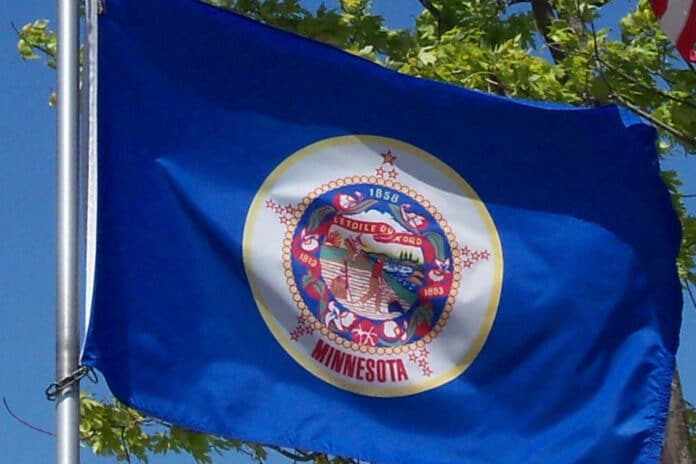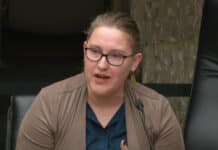Membership of a new commission tasked with redesigning the Minnesota state flag and seal was supposed to be finalized earlier this month. But it appears it’s not quite ready to begin its work, which is to be completed and sent to the legislature by Jan. 1, 2024.
While Gov. Tim Walz appointed three members of the public to the 17-member State Emblems Redesign Commission earlier this month, a handful of appointees from state councils and agencies had not yet been listed as filled on the webpage for the body as of Monday. The commission was supposed to be finalized by Aug. 1, according to statute.
In total, the commission will be comprised of 13 voting members, and four ex-officio (non-voting) members from the House and Senate. Each chamber has one Republican and one DFL appointee to the commission. The Senate GOP caucus told Alpha News that Sen. Steve Drazkowski, R-Mazeppa, will serve on the commission.
Throughout the legislative session DFL bill sponsors in the House and Senate pushed legislation to redesign the state seal and flag in an effort to “retire” what they said are a failure in vexillology design principles and racist overtones toward the American Indian community.
Several Republicans criticized the push for a new state flag, and advocated for the legislature having the final say after the State Emblems Redesign Commission submits its final design recommendations before the end of this year. Ultimately, Democrats got their way.
DFL leaders tucked the emblem redesign legislation inside an omnibus state government bill, which passed in the DFL controlled House and Senate. The statute gives power to the newly-created commission to begin its work by Aug. 1 and send its redesign plans for the state seal and flag to the legislature before the end of the year. The commission will convene at the call of an appointee designated by Walz. In its design process deliberations the commission must “solicit public feedback and suggestions to inform its work,” the new law reads. Decisions of the commission must be made by majority vote.
The statute instructs that the commission’s designs “must accurately and respectfully reflect Minnesota’s shared history, resources, and diverse cultural communities.
“Symbols, emblems, or likenesses that represent only a single community or person, regardless of whether real or stylized, may not be included in a design. The commission may solicit and secure the voluntary service and aid of vexillologists and other persons who have either technical or artistic skill in flag construction and design, or the design of official seals, to assist in the work.”
While the legislature will review the final designs, the statute instructs that “the design of the state flag as certified in the report of the State Emblems Redesign Commission, as established by this act, is adopted as the official state flag” and will become official on May 11, 2024 — which happens to be the anniversary of Minnesota’s statehood. Republicans lobbied hard for the legislature to have the final say on the redesigned state seal and flag. But DFL legislators stuck with their original language in a final conference report on the bill.
Walz’s picks include tribal council member, tribal judge and former DFL senate candidate
The commission is comprised of three members of the public appointed by the governor, two state senators and two representatives from the state house (chosen by DFL and Republican leaders), and representatives chosen by the Minnesota Historical Society, state tourism board, state capitol architectural board, and state arts board.
The commission is also set to include representatives chosen from the following organizations: The Council for Minnesotans of African Heritage, Minnesota Council on Latino Affairs, Council on Asian-Pacific Minnesotans and two members appointed by the Indian Affairs Council.
Walz announced his appointees on July 28. They are Shelley Buck, vice president for the Prairie Island Tribal Council, Anita Gaul, a former DFL state Senate candidate and community college history teacher from Worthington, and tribal law attorney and judge Michael Harralson of Minneapolis.
The Secretary of State, Capitol Area Architectural and Planning Board, Explore Minnesota Tourism Council, Minnesota State Arts Board and Minnesota Historical Society have also “filled” their positions to serve on the commission. But specific names weren’t yet posted on the commission webpage as of Monday. The Minnesota Historical Society said its director and CEO, Kent Whitworth, will sit on the commission.
Requests for comment from each of the other agencies and the Office of the Secretary of State were not returned Monday.
Just two appointees from among the ethnic councils were listed as officially selected on the commission webpage.
Artist/designer Luis Fitch was appointed to the commission by the Minnesota Council on Latino Affairs. Photographer Kim Jackson was appointed by the Council on Asian-Pacific Minnesotans. Commission members appointed by the Dakota and Ojibwe communities, and Council for Minnesotans of African Heritage have not yet been listed as filled.
Update, Aug. 16: Sen. Mary Kunesh, DFL-New Brighton, will be the Senate DFL’s appointee to the commission. The Council for Minnesotans of African Heritage said it has appointed Denise Mazone. This story was also updated Aug. 15 with comment from the Senate GOP and the Minnesota Historical Society.
Hank Long
Hank Long is a journalism and communications professional whose writing career includes coverage of the Minnesota legislature, city and county governments and the commercial real estate industry. Hank received his undergraduate degree at the University of Minnesota, where he studied journalism, and his law degree at the University of St. Thomas. The Minnesota native lives in the Twin Cities with his wife and four children. His dream is to be around when the Vikings win the Super Bowl.















